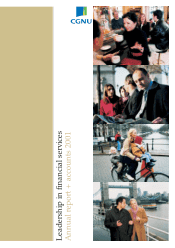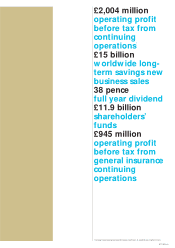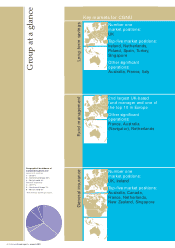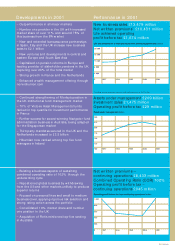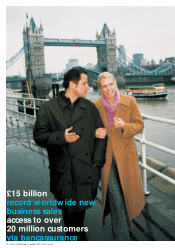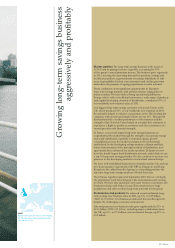Aviva 2001 Annual Report Download - page 8
Download and view the complete annual report
Please find page 8 of the 2001 Aviva annual report below. You can navigate through the pages in the report by either clicking on the pages listed below, or by using the keyword search tool below to find specific information within the annual report.
06 CGNU plc Annual report + accounts 2001
Overview
Introduction During my first year as group chief executive of
CGNU we have taken further important steps forward in line with
our strategic objectives. Significant progress has been made in
repositioning and strengthening the group as one of the world’s
major insurers while, at the same time, achieving increased operating
profit and record long-term savings new business sales.
Our focus is on our three core businesses – long-term savings, fund
management and general insurance. Some 70% of our premiums
come from long-term savings, with the remaining 30% from general
insurance (2000: 67%-33%).Ninety per cent of our total business
comes from Europe, which makes CGNU’s presence in Europe the
largest of any UK-based insurer (2000: 89%).
Long-term savings business in Europe is a market that we expect to
develop strongly as the responsibility for providing financial support
for ageing populations increasingly shifts from the state to the private
individual. In addition, we believe customers will continue to seek
the reassurance of trusted brands providing high-quality products
and services.
Building for the future The group now holds top-five positions in
many key markets, a good position from which to build. This growth
is being achieved through the organic development of existing
businesses and through acquisitions, partnerships and new ventures
that extend our distribution capabilities.
Effective and flexible methods of distribution, tailored for individual
markets, are important because we believe they will help us achieve
our ambitious growth targets. For example, while financial advisers
generate around 75%of our long-term savings business in the UK,
bancassurance accounted for nearly 90% of our combined new
business sales in Spain and Italy in 2001.
A significant achievement last year was the further strengthening
of our bancassurance partnerships in Spain, Italy and Singapore,
and continuing development in the UK. These distribution
arrangements give the group access to more than 20 million
potential customers worldwide.
Strategic acquisitions were made, at the right price, to increase
shareholder value. For example, our acquisition of Fortis Australia in
July consolidated our top-five position in the Australian general
insurance market.
We also made a number of smaller acquisitions in strategic and
emerging markets. Our Dutch company, Delta Lloyd, bought Bank
Nagelmackers, an important step in developing the Delta Lloyd
savings and investment business in Belgium.
The acquisition of Mébit, the sixth-largest life insurance business in
Hungary, strengthens our position in the long-term savings markets
of central and eastern Europe. We continue to develop our operations
in these newer, dynamic markets, including Poland and Turkey
(where we already hold top-five positions), Romania and Lithuania.
Group Chief Executive’s review
“We have
reshaped the
business and built
a strong base for
profitable growth”
£317 million
integration
savings

